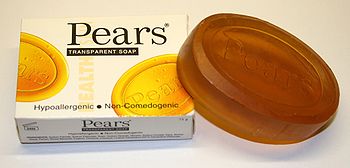
Glycerin soap
Encyclopedia

Soap
In chemistry, soap is a salt of a fatty acid.IUPAC. "" Compendium of Chemical Terminology, 2nd ed. . Compiled by A. D. McNaught and A. Wilkinson. Blackwell Scientific Publications, Oxford . XML on-line corrected version: created by M. Nic, J. Jirat, B. Kosata; updates compiled by A. Jenkins. ISBN...
s that contain glycerin, a component of fat or oil. The soap is recognizably different from other soaps because it is translucent. The clarity of the soap is due to the particular alignment of the soap molecules in this type of soap, which can be induced through the addition of alcohol and sugar. This is usually done for homemade glycerin soaps which are not remeltable.
The process for making glycerin soaps was well known as of 1857 in the Western world. In modern industrial soap-making, the glycerin is then usually separated from the soap to be resold and used in a wide variety of areas such as for personal care products, pharmaceuticals, chemical intermediates, and food processing.
Production
Glycerin soap is made by melting and continuously heating soap that has been partially dissolved in a high percentage alcohol solution until the mixture reaches a clear, jelly-like consistency. The alcohol is added to a slow cooked hot-processed soap and then simmered with a sugar solution until the soap is clear or translucent, and then the simmered soap is chilled in a freezer. With home- and hand-made soaps that still contain glycerin left over from saponificationSaponification
Saponification is a process that produces soap, usually from fats and lye. In technical terms, saponification involves base hydrolysis of triglycerides, which are esters of fatty acids, to form the sodium salt of a carboxylate. In addition to soap, such traditional saponification processes...
, the grating, melting and cooking can proceed without the addition of anything into the mixture, though sugar
Sugar
Sugar is a class of edible crystalline carbohydrates, mainly sucrose, lactose, and fructose, characterized by a sweet flavor.Sucrose in its refined form primarily comes from sugar cane and sugar beet...
or more glycerin is sometimes added. Glycerin soap can also be produced without remelting soap through directly cooking raw home-made soap.
Modern clear glycerin soaps bases are produced by combining various glycerol
Glycerol
Glycerol is a simple polyol compound. It is a colorless, odorless, viscous liquid that is widely used in pharmaceutical formulations. Glycerol has three hydroxyl groups that are responsible for its solubility in water and its hygroscopic nature. The glycerol backbone is central to all lipids...
and polyol
Polyol
A polyol is an alcohol containing multiple hydroxyl groups. In two technological disciplines the term "polyol" has a special meaning: food science and polymer chemistry.- Polyols in food science :...
s with soap and other surfactant
Surfactant
Surfactants are compounds that lower the surface tension of a liquid, the interfacial tension between two liquids, or that between a liquid and a solid...
s in a manner similar to traditional glycerin soap making methods. These modern clear soaps have the benefit of being easily re-meltable and are often sold in bulk to customers for melt-and-pour soap crafting.

